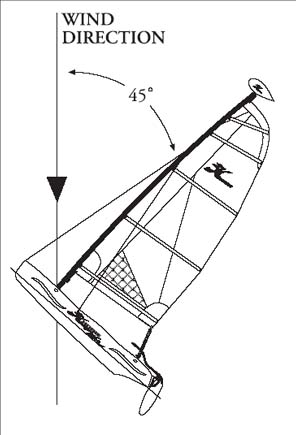At a combined 360 lbs, you will have NO problem righting the boat. If it's a '79 H18, the mast is probably all aluminum (no fiberglass comptip), so the chances of it leaking are slim. There are still rivets in the mast that could be loose and allow leaks, but even if they do, I'm sure you'll be able to get it back upright with plenty of time to spare (I also have a '79 H18). The mast alone has enough buoyancy to keep the boat propped up on it's side. I've heard that it's still possible to turtle with the boat even if your mast doesn't leak, but I've never seen it, and I've capsized at least a dozen times. It seems that it would take a lot of wind and very rough seas to make that happen. I even pitchpoled my boat at one point and almost completely turtled, and it STILL came back up on it's side. Of course, a mast float will ensure that you'll never turtle the boat, but it's typically not necessary.
One thing to note is that a mast float will make the mast somewhat heavier when stepping the mast, and will also require just a little bit more weight to right. Based on past experience, I know my boat takes ~295 lbs to right. I've tried it with ~285 lbs to no avail, and I've tried it with 300 lbs without any problem. I'd expect that with a mama-bob, you might need 310 lbs to right the boat. Maybe someone else can chime in on that one.
Capsizing & recovering is really no big deal, once you've done it once before. And it gets you much more comfortable with the boat and gives you a better feel for how far you can push it. You'd be amazed how far over you can go and still recover from it! Capsizing sounds violent and terrifying, but it's not at all. (pitchpoling is, however.

Luckily, that's a lot harder to do!

) Once the boat gets up above 20-30 degrees, the side force/heeling moment on the sail decreases rapidly, and the sail seems to act as more of a "parachute," slowing the capsize. The safest way to sail in gusty conditions is to sit on the edge of the windward hull. As the boat lifts up, lean/scoot back so that your butt is more on the side of the lip. By the time the mast hits the water, you should be sitting on the side of the hull. It takes 3-5 seconds to actually go over. From there, it's simply a matter of jumping off the back (thus avoiding the sails), swimming around to loose the mainsheet & traveller, furl the jib, spin the boat around so that the mast & bows are each pointing 45 degrees to the wind, grabbing on to your righting line and leaning back. your weight should be more than enough to bring the boat back upright. Be careful to avoid being hit by the hull coming down above you, and grab onto the crossbar to keep the boat from going back over the other way. Also, don't stand on the daggerboard, as your toes could get caught in between the daggerboard and the trunk if the daggerboard slips. It sounds scary, but it's really not bad. I'd suggest getting a righting line/painter (I use the Easy Rite from the Hobie catalog with much success).
Not a Hobie 18, but these should give you some idea of what to expect:
https://www.youtube.com/watch?v=0rdN7ZFU5QYhttps://www.youtube.com/watch?v=XqY_zMlETo0The best way to AVOID a capsize is to keep the traveller out a bit, keep the main/jib sheet un-cleated and in your hand so you can ease it as necessary, and/or "pinch" up (turn up) into the wind whenever a big gust hits you. Any one of these solutions essentially decreases the angle of attack of the sail, decreasing or eliminating the lift and keeping the boat from going over.
The biggest thing is not to be afraid of a capsize. Get a few sails under your belt so that you're comfortable with the boat, and then practice capsizing and righting it. As soon as you have, you understand how to react both to prevent it, and what to do when it happens unexpectedly. It also makes it less intimidating. Hell, capsizing just means you pushed the boat as hard as you can go, and sometimes it's just a fun way to cool off!

Happy sailing!







